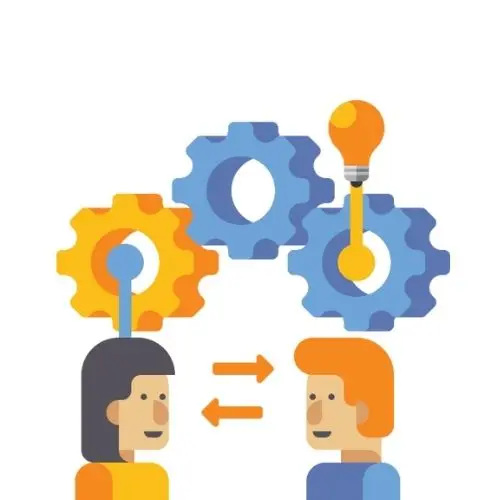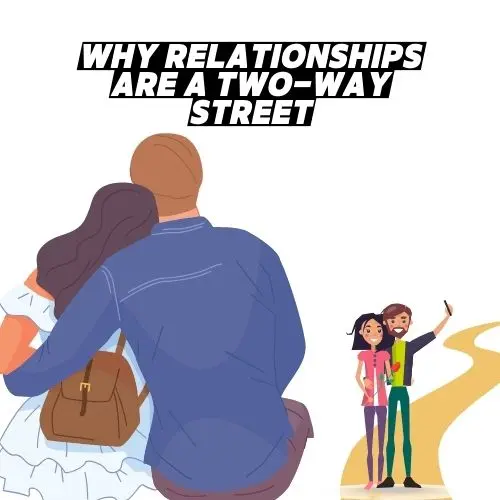Introduction
A relationship requires effort from both people involved in order to thrive. The adage that “relationships are a two-way street” conveys an important truth – both partners must actively work to understand each other and meet halfway. A one-sided relationship where only one person puts in effort is unbalanced and unsustainable. For a relationship to be healthy and stand the test of time, it must be nurtured by both people. This takes ongoing commitment, empathy, and compromise.
| Number of marriages in the US (2020) | 1,747,000 |
| US divorce rate (2020) | 14.9 per 1,000 marriages |
| The average duration of marriages ending in divorce | 12 years |
| Top reasons for divorce | Lack of commitment, infidelity, constant arguing |
| Keys to a successful relationship | Communication, trust, compromise, shared values |
Why Relationships Fail When They’re One-Sided

Many relationships falter when one partner is putting in significantly more effort than the other. Some signs that a relationship is one-sided include:
- One person makes most of the sacrifices and compromises. They put their partner’s needs first and suppress their own needs and desires.
- Lack of mutual understanding. One partner does not try to understand the other’s perspective.
- The emotional burden falls predominantly on one person. One partner does most of the work to foster intimacy.
- One person does most of the initiating and planning for dates or quality time. The other does not reciprocate.
- Unequal investment and interest. One partner is clearly less engaged and committed to the relationship.
Over time, the person putting in more effort grows resentful while the other takes the relationship for granted. The disengaged partner may fail to appreciate the sacrifice and work of the other person. This leads to tension, arguments, disenchantment, emotional withdrawal, and ultimately breakups or divorce.
Partners who refuse to adjust their behavior or put in effort end up draining their loved one’s energy and eroding the foundation of the relationship. One person cannot sustain a healthy relationship alone. It requires reciprocal care and understanding.
Communication: The Key to a Two-Way Street

The cornerstone of a strong, balanced relationship is open and honest communication between partners. Some tips for effective two-way communication include:
- Active listening: When your partner is speaking, engage with full attention and reflect on what they are expressing. Don’t just wait for your turn to talk.
- ** Validating each other’s experiences:** Avoid dismissing, critiquing, or judging your partner’s feelings and perspectives. Even if you disagree, show you understand where they are coming from.
- Speaking vulnerably: Express your true thoughts and feelings. Don’t hold back out of fear, ego, or resentment. Speaking authentically strengthens intimacy.
- Non-defensive responses: If your partner raises concerns or critiques, do not get defensive. Thank them for their honesty and reflect on their words.
- Compromise: Be willing to meet your partner halfway, even if it means sacrificing some of your own preferences or desires. Compromise should come from both sides.
- Disagree respectfully: It’s unhealthy to avoid difficult conversations. Disagree openly but calmly. Do not make personal attacks or use hurtful language.
- Equal turns: Make sure the conversation flows both ways. One person should not dominate. Each partner should speak and be heard.
Good communication requires mutual effort. Words must be spoken clearly and received openly. It bridges the space between partners, connecting their worlds. Without quality communication, relationships have no solid ground to stand on.
Building Trust Through Dependability & Vulnerability

Trust is vital for any relationship to feel secure. When trust is broken, it can be very difficult to regain. What creates unshakeable trust between partners?
Dependability – When one partner proves themselves to be utterly dependable, it instills faith. They consistently follow through on promises, no matter how small. They are responsible for finances. They are truthful about where they spend their time. They make their partner feel like a priority.
Vulnerability – Allowing oneself to be vulnerable requires bravery and trust. When partners are vulnerable with each other, they form a deep emotional bond. They are not afraid to reveal their fears, dreams, shame, or past hurts. This level of openness is liberating and brings partners into more intimacy.
In the best relationships, both people demonstrate dependability and vulnerability. However, getting there requires effort from each person:
- Don’t hide things from your partner. Share your full self.
- If you sense trust is fading, have an honest conversation about it.
- Ask what behaviors from you would help build more trust. Listen without defensiveness.
- Create habits and rituals that nurture closeness, like regular date nights and daily check-ins.
- Follow through 100% of the time on what you say you will do. Don’t make excuses.
- Show you care by remembering and respecting what matters to your partner. Prioritize them.
- Apologize fully when you make a mistake rather than downplaying it. Explain how you’ll avoid repeating it.
Rebuilding broken trust requires demonstrating you’ve changed through your actions, not just your words. While it takes two to build trust, one person can initiate this process through heartfelt effort.
Shared Values Yield a Stronger Bond

People like to say “opposites attract” when it comes to relationships. But actually, research shows partners with shared values, interests and priorities have higher relationship satisfaction and longevity. Having compatible values acts as a strong adhesive that binds couples together through life’s ups and downs.
Consider important areas like these:
Faith/Beliefs – For couples who practice the same religion or have a shared higher purpose, their relationship has a spiritual anchor. They have similar lifestyle habits and ways of navigating challenges by drawing on faith.
Family – Partners who share priorities around family dynamics, having kids, parenting styles, and work-life balance are aligned on major life decisions.
Ambition – Couples thrive when they support each other’s career goals and are equally motivated. Resentment brews if one person is significantly more driven.
Worldview – A socially conscious person may have trouble relating to someone apathetic about societal problems and vice versa. Core values around humanitarianism, politics, etc., should align.
Finances – Arguments often arise because of different spending habits, cheap vs. lavish tastes, disagreements over savings, and who controls the money. Shared financial priorities prevent tension.
Interests – Having hobbies or interests in common—or an eagerness to participate in each other’s passions—keeps couples engaged in shared activities.
A major area of contrast like religion, kids, or money can drive partners apart if there’s no willingness to find compromise. Successful couples recognize their differences but focus more on aligning their lives around common values and goals.
Overcoming Hardships Together

All relationships experience periods of hardship, tension, and dissatisfaction at some point. These low points test a couple’s resilience. Can disagreements be resolved constructively? How well do partners support each other through external stressors like work crises, illnesses, family trauma, or financial burdens?
Relationships that stand the test of time are not immune to difficulties. However, resilient couples approach hardships with mindfulness, empathy and active effort from both sides:
- They tackle issues as a team rather than pointing blame or viewing each other as adversaries.
- They offer reassurance and encouragement when their partner feels vulnerable or defeated during tough times.
- They accept imperfections and avoid harsh criticism when stressed.
- They express appreciation and gratitude rather than taking each other for granted.
- They listen closely, understand each other’s burdens, and provide emotional support.
- They are committed to finding workable solutions together and willing to sacrifice when needed.
Partners who coast through extended periods of complacency take each other and their relationship for granted. Hardships present an opportunity to reinforce bonds through shared tribulation. Each person must rise to the occasion by being present and lending their strength to buoy the other. Leaning on each other eases burdens and brings mutual growth.
Initiating Positive Change

It’s easy to get stuck in patterns of negative or lackluster relating that drain relationships of joy and intimacy. Partners may begin interacting more like roommates or colleagues than passionate lovers. If the relationship feels one-sided, stagnant, or routinely unsatisfying, there are ways one partner can initiate positive change:
Spark new conversations – Draw each other out on fresh topics that go deeper. Ask thoughtful questions. Share your dreams and revelations.
Plan surprise getaways –Spontaneously whisk your partner away for a weekend of hikes in nature, wine tasting, or relaxing at a cozy cabin to reconnect.
Send unexpected notes – Leave loving sticky notes in random places. Send affectionate texts while apart at work. Mail handwritten cards.
Try marriage counseling – If communication has broken down, consider sessions to unpack.
Signs of a One-Way Street
Some red flags that suggest a relationship is imbalanced include:
- One partner does most of the emotional labor
- Double standards are apparent (e.g. one person can act in ways the other is forbidden)
- Most compromises come from only one person
- One partner’s needs and preferences dominate
- One person does the majority of household work
- The same person initiates most visits, calls, dates, and sex
- One partner consistently disregards the other’s needs and desires
The Rewards of a Two-Way Street
While strengthening a relationship into a healthy two-way street requires insight, effort, and perseverance, the rewards are well worth it. Benefits include:
- A deeper sense of connection, intimacy, and friendship
- Greater trust, honesty, and ability to be vulnerable with each other
- A more satisfying and passionate sex life
- Shared vision, values, and goals reinforce unity
- More fun, laughter, and adventures together
- Improved ability to communicate empathetically
- Conflicts get resolved quickly and respectfully
- A nurturing partnership built on reciprocity rather than inequity
- Better support through life’s highs and lows
- Increased gratitude and appreciation for each other.
Conclusion
In conclusion, relationships thrive when there is mutual understanding, trust, intimacy, support, compromise, and consistent effort. Partners who embrace this mindset and commit to showing up fully for each other are rewarded with deeper fulfillment, meaning, and lasting love. With insight and conscious actions, any relationship can become a two-way street.


1 thought on “Why Relationships Are a Two-Way Street: Facts and Insights”